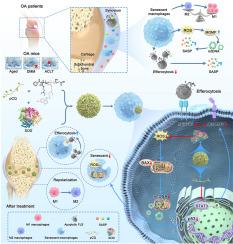Remodeling of senescent macrophages in synovium alleviates trauma- and aging-induced osteoarthritis
IF 18
1区 医学
Q1 ENGINEERING, BIOMEDICAL
引用次数: 0
Abstract
Osteoarthritis (OA) is one of the most concerned aging-related diseases in the worldwide, yet the investigation of immune senescence in joint and related therapies are still poorly identified. Single-cell sequencing analysis and immunofluorescence of OA synovium reveal increased senescent macrophages in trauma-induced OA compared to controls. Importantly, senescent macrophages in OA synovium showed enhanced M1 polarization, mitochondrial damage and impaired efferocytosis, which could lead to increased senescence-associated secretory phenotypes (SASPs) in the joint and further exacerbate OA. Hence, a novel senotherapeutic nanoparticle is developed using chloroquine (CQ)-bearing polymers (pCQ) for targeted delivery of superoxide dismutase (SOD) to synovial macrophages, termed as pCQ/SOD. The nanoparticle achieves efficient intracellular delivery of SOD to synovial macrophages. RNA-seq results reveal that pCQ/SOD nanoparticle inhibits macrophage senescence via p53 and cellular senescence signaling pathway, further reprograms M1-to-M2 repolarization. Furthermore, the delivered SOD inhibits BAX-dependent mitochondrial outer membrane permeabilization (MOMP) which further reduces mitochondrial DNA (mtDNA) release and SASP secretion, while pCQ promotes macrophage efferocytosis against apoptotic cells via STAT3/ADAM17/MerTK signaling. As a result, intraarticular injection of pCQ/SOD nanoparticles in mice successfully alleviates not only trauma-induced OA, but aging-induced OA as well. The developed senotherapeutic nanoparticle in this study offers an effective approach for remodeling of senescent macrophages in synovium and a promising therapeutic strategy for OA treatment.

滑膜中衰老巨噬细胞的重塑减轻创伤和衰老诱导的骨关节炎
骨关节炎(Osteoarthritis, OA)是世界范围内最受关注的衰老相关疾病之一,但对关节免疫衰老的研究和相关治疗仍知之甚少。单细胞测序分析和OA滑膜免疫荧光显示,与对照组相比,创伤性OA中衰老巨噬细胞增加。重要的是,OA滑膜中衰老的巨噬细胞表现出M1极化增强、线粒体损伤和efferocytosis受损,这可能导致关节中衰老相关分泌表型(senescence associated secretory phenotypes, sasp)增加,进一步加剧OA。因此,利用含氯喹(CQ)的聚合物(pCQ)开发了一种新型的衰老治疗纳米颗粒,用于将超氧化物歧化酶(SOD)靶向递送到滑膜巨噬细胞,称为pCQ/SOD。纳米颗粒实现了滑膜巨噬细胞内SOD的高效细胞内递送。RNA-seq结果显示,pCQ/SOD纳米颗粒通过p53和细胞衰老信号通路抑制巨噬细胞衰老,进一步重编程m1 - m2复极化。此外,传递的SOD抑制bax依赖的线粒体外膜渗透(MOMP),进一步减少线粒体DNA (mtDNA)释放和SASP分泌,而pCQ通过STAT3/ADAM17/MerTK信号通路促进巨噬细胞对凋亡细胞的efferocytosis。结果表明,小鼠关节内注射pCQ/SOD纳米颗粒不仅可以成功减轻创伤性OA,还可以减轻衰老性OA。本研究开发的衰老治疗纳米颗粒为滑膜中衰老巨噬细胞的重塑提供了一种有效的方法,为OA治疗提供了一种有前景的治疗策略。
本文章由计算机程序翻译,如有差异,请以英文原文为准。
求助全文
约1分钟内获得全文
求助全文
来源期刊

Bioactive Materials
Biochemistry, Genetics and Molecular Biology-Biotechnology
CiteScore
28.00
自引率
6.30%
发文量
436
审稿时长
20 days
期刊介绍:
Bioactive Materials is a peer-reviewed research publication that focuses on advancements in bioactive materials. The journal accepts research papers, reviews, and rapid communications in the field of next-generation biomaterials that interact with cells, tissues, and organs in various living organisms.
The primary goal of Bioactive Materials is to promote the science and engineering of biomaterials that exhibit adaptiveness to the biological environment. These materials are specifically designed to stimulate or direct appropriate cell and tissue responses or regulate interactions with microorganisms.
The journal covers a wide range of bioactive materials, including those that are engineered or designed in terms of their physical form (e.g. particulate, fiber), topology (e.g. porosity, surface roughness), or dimensions (ranging from macro to nano-scales). Contributions are sought from the following categories of bioactive materials:
Bioactive metals and alloys
Bioactive inorganics: ceramics, glasses, and carbon-based materials
Bioactive polymers and gels
Bioactive materials derived from natural sources
Bioactive composites
These materials find applications in human and veterinary medicine, such as implants, tissue engineering scaffolds, cell/drug/gene carriers, as well as imaging and sensing devices.
 求助内容:
求助内容: 应助结果提醒方式:
应助结果提醒方式:


